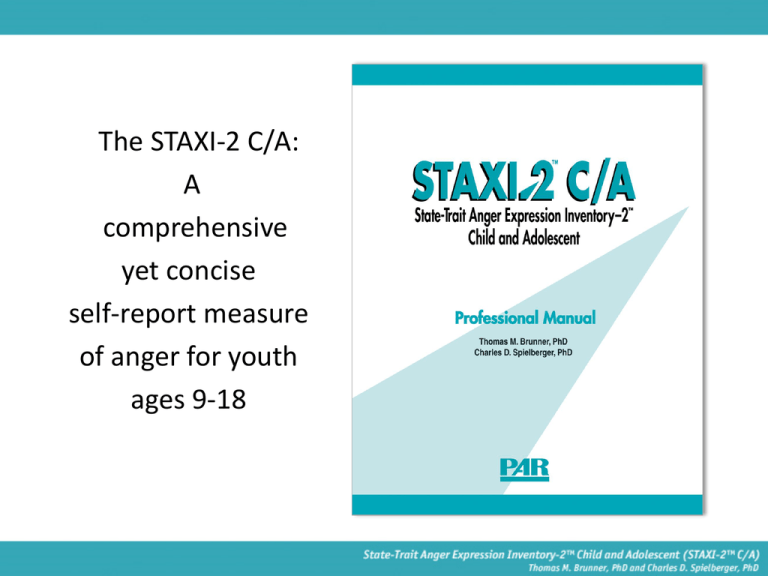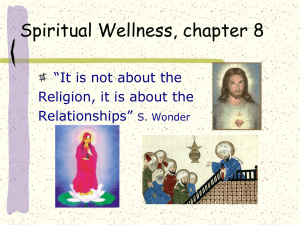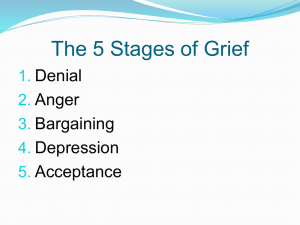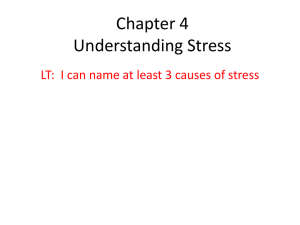STAXI-2™ C/A - Psychological Assessment Resources, Inc.
advertisement

The STAXI-2 C/A: A comprehensive yet concise self-report measure of anger for youth ages 9-18 Presentation organization • Section 1: Introduction • Section 2: Relating the Adult STAXI-2 to its Youth Adaptation: the STAXI-2 CA • Section 3: In-depth review of the STAXI-2 CA • Section 4: The STAXI-2 CA Interpretative system • Section 5: Sample report, test form and booklet • Section 6: STAXI-2 C/A Manual References Section 1: Introduction STAXI-2 C/A Authors -Thomas M. Brunner, PhD• Child/Adolescent Assessment and Treatment Expert • Developmental Psychologist/Researcher • Founder and Director: Center for Character Strength Investment (CSI) • Research Associate: Center for Research in Behavioral Medicine and Health Psychology (University of South Florida, Tampa, FL) STAXI-2 CA Authors (cont’d) -Charles D. Spielberger, PhD• Founder & Director: Center for Research in Behavioral Medicine and Health Psychology (University of South Florida, Tampa, FL) • Distinguished Research Professor, University of South Florida • Developer of leading self-report measures used worldwide • Major innovation: The “State-trait” distinction – E.g., State-Trait Anxiety Inventory (STAI) • Adapted into 72 languages • Most widely used measure of anxiety To Receive Updates Regarding Research With the STAXI-2 C/A • Email Dr. Thomas Brunner* solutions@doctorbrunner.edu • Email Dr. Charles Spielberger spielber@usf.edu *Dr. Brunner will soon be starting an anger blog to discuss the latest developments in anger assessment. Email him to have your name added to the member list. The Concept of “State” versus “Trait” • State-trait distinction now widely accepted in field of psychology • Most measures (e.g., MMPI-2) confuse states vs. more trait-like phenomena • State and trait concepts are moderately correlated, but represent highly differentiable clinical phenomenon • Definitions: – State: Temporary, often highly transient event (e.g, tantrum) – Trait: Relatively stable, more enduring tendency (e.g., externalizing anger coping style) The STAXI-2 C/A is a member of a wellknown and widely used state-trait family of measures • State Trait Anxiety Inventory (STAI) – Most widely used adult measure of anxiety in world • State Trait Anxiety Inventory for Children (STAIC) • State Trait Personality Inventory (STPI) • State Trait Anger Expression Inventory, Second Edition (STAXI-2) Why build on the adult STAXI-2 anger measure? • • • • • Based on over 35 years of research One of the most widely used measure of anger in the world Uniquely multidimensional (6 scales, 5 subscales) Concise yet comprehensive Widely used in research and applied settings – Medical, psychological, educational, forensic (e.g. high blood pressure/Type A relationship) Why build on the STAXI-2? (cont’d) • Robust lineage of validity data with diverse youth populations (See table 1.3) • Over 100 studies have already used state-trait concepts with youth • Concepts correlated with over 20 established measures of anger (See Table 1.3) • Spanish youth version of STAXI-2 exemplifies cross-cultural validation as well • Used with older adolescents for over 20 years • State-trait concepts have strong psychometric properties with youth e.g., del barrio (2004); Hagglund et al., 1994 What is unique about the STAXI-2 C/A? • Paucity of anger measures for children/adolescents • 35 years of empirical and theoretical state-trait literature had already led to state-trait adult anger measure (i.e,, STAXI-2) • Numerous authors (e.g., Feindler, 1992) called for a youth adaptation of the STAXI-2 • Need for a concise yet comprehensive measure that is developmentally sensitive • Need to assess experience, expression, and control of anger while accounting for state and trait aspects of anger • Need to create an “anger profile” capturing clinical facets of anger that together map the anger process in each individual • Need for a measure that can complement formal risk measures that may not assess anger in detail because they focus on risk factors surrounding the person, not internal anger dynamics The STAXI-2 C/A addresses problems with other anger measures, such as how they… • Confuse/lump together experience, expression, and control of anger • Ignore validated & widely accepted state-trait distinction – Which has particular applicability for youth (e.g., must distinguish temporary tantrum vs. trait-like predisposition) • Lack of sensitivity to low scores – E.g., sole focus on if score is high enough to meet threshold – Problem: low levels of certain anger facets (e.g., anger control) also significant • Produce isolated scores, not an “anger profile”, where the nature of the score is understood as one part of the overall anger process for that individual Section 2: Relating the Adult STAXI-2 to its Youth Adaptation: the STAXI-2 CA The STAXI-2 and the STAXI-2 CA measure nearly identical facets of anger Like the STAXI-2, the STAXI-2 C/A provides a comprehensive anger profile assessing experience, expression, and control of anger, while accounting for both state and trait aspects of anger. Process of Adapting STAXI-2 to STAXI-2 CA • Psychometrically assess applicability of STAXI-2 scale/subscale concepts for children ages 9-18 • Adapt measure items and instructions down to 4th grade reading level • Robustly represent each state-trait concept along its continuum of frequency and/or intensity • Use combination of factor analysis and rational means to narrow final item pool • Use large sample (N=>800) representing population to choose items With the STAXI-2 CA, there was emphasis on developing a sensitive measure • Groups of scale/subscale items were chosen that assess the full spectrum of intensity/frequency of that scale/subscale concept • This allows for measurement of higher & lower levels of key facets of the anger process (rather than having a cut-off score only) • We accounted for the notion of “item-intensity specificity”, which highlights how some self-report items tend to capture a certain range of intensity/frequency along that phenomena’s continuum: – Concept from Anastasi, 1982; re-emphasized by Spielberger, et al., 1988 – E.g., “I am frustrated” assesses a lower level (i.e., range) of anger than “I feel like kicking someone”, which assesses a higher range of anger Overview: STAXI-2 vs STAXI-2 CA • Adult STAXI-2 (57 items) vs briefer STAXI-2 C/A (35 items) • Simplified text (4th grade readability) • Conceptual structures very similar • Two main conceptual differences 1) CA: 1 less scale (Anger Control not empirically differentiable) 2) CA: 1 less subscale (State Anger less empirically differentiable) Using the STAXI versus the STAXI-2 CA • Official Age ranges: – STAXI-2: 16 to 63 – STAXI-2 CA: 9-18 (4th grade reading level) • Factors to also consider if person is 16-18 years of age: – What is their developmental level (e.g., IQ) • Lower IQ indicate usage of STAXI-2 C/A – Need for retesting as they become adult? • May need to use STAXI-2 Section 3: In-depth review of the STAXI-2 CA STAXI-2 CA - Overview • Purpose: Comprehensively yet concisely assess experience, expression, and control of anger while accounting for state and trait aspects • Type of measure: Self-report • For: Ages 9-18 years • Time: 10 minutes to administer; 5 to score STAXI-2 CA: Conceptual overview • Comprehensive, yet concise – 5 scales, 4 subscales – 13 “concerning” items that can help screen for risk • Non-overlapping, conceptually clear scales & subscales – Based on robust empirically based literature – Each scale/subscale assesses a key clinical facet STAXI-2 CA – Psychometric Overview • Large census matched normative base • State-trait concepts - robust validity correlation data • Strong alphas for control and clinical group • Scales differentiated clinical vs. controls STAXI-2 C/A – Patterns among scale and subscales • Since majority of scales assess frequency of anger, moderately positive relationships expected • However, the AX-I and AC assess the suppression or control of anger, so negative relationships expected • For both the Normal and Disruptive sample, these patterns were exhibited • For the Disruptive sample, there was a particularly strong negative correlation between T-Ang and AC, and this makes sense clinically • General principle: the stronger a personality trait, the more probable that the emotional state corresponding to that trait will be reported at higher levels as well (Spielberger, 1972). How does the STAXI-2 C/A conceptual structure assist with school, clinical, or forensically based risk assessments? -Current risk assessment measures focus more on risk factors, not on the internal or more “hidden” aspects of anger (e.g., suppressed anger) -For example, whether someone internalizes anger may not be assessed by a risk assessment measure, but is assessed by the STAXI-2 C/A -Thus, the STAXI-2 C/A complements current forensic risk measures such as the SAVRY [Borum, et al., 2003]) Notable STAXI-2 C/A References • Used in ongoing Center for Disease Control funded study (Michele Ybarra, PhD, principal investigator) • Leading international learning expert (Nancy Mather, PhD) coauthor of Woodcock-Johnson test recommendation book, included chapter (authored by Brunner) highlighting value of STAXI-2 C/A in assessing learning problems STAXI-2 CA – Subfield applications • • • • • Clinical psychology* School psychology* Forensic psychology* Medical psychology* Positive psychology *Real life case example in manual Section 4: STAXI-2 CA Interpretive system Interpretation - Overview • Uniquely comprehensive profile – Recognizes and evaluates anger as a process – The dynamic human anger process: • First we experience, then we express, then we control to some degree – This STAXI-2 C/A anger profile, from left to right, proceeds from experience, to expression, to control Interpretation - Overview • Well-rounded, integrated scoring system – Primarily percentile based chart • Percentiles allow for fine grained sense of persons standing on that scale compared to peers – Augmented by T score chart • T scores allow for comparisons between scales/measures Interpretation – Quick Process & Clear Guidelines • Quickly hand score anger scales & subscales (5 minutes) • Then transfer to %tile and T score profiles sheets • Use thumbnail text summaries for High/Low score interpretation (see table 5.5) • Step-by-step instructions offered in Manual to enhance precision (helpful for forensic contexts) • Each score given meaning within framework of anger profile • Profile allows evaluator to view anger as a process: – From experience, to expression, and control Section 5: Sample report, test form and booklet After interpreting, how would one write up the findings? The following is a real life clinical example in the STAXI-2 Professional Manual Sample Psychological Report for Case Example 1: D.S. The STAXI-2 C/A was administered to D.S., a 15-year-old Caucasian high school freshman boy, to assess his experience, expression, and control of anger. D.S.’s anger profile was evaluated by comparing his scores on the STAXI-2 C/A scales and subscales with normative data for males between 15 and 18 years of age. D.S.’s percentile rank and T-score profiles are included with this report. D.S.’s STAXI-2 C/A S-Ang percentile rank suggests he did not experience an Elevated level of anger at the time of evaluation. However, his S-Ang/F percentile rank of 66 is near the upper end of the Average range, suggesting above-average feelings of annoyance. D.S.’s general disposition to experience anger was also evaluated. His T-Ang subscale percentiles indicate a significant disparity between his nearly Elevated T-Ang/T score (i.e., 73rd percentile) and his Low T-Ang/R score (i.e., 23rd percentile). A further review of this disparity, using a T-score comparison approach, suggests an important difference, which indicates that D.S. tends to experience anger frequently across situations. However, when he is being evaluated or criticized, he tends to experience anger to a notably lesser extent than do his similarly aged male peers. Sample Psychological Report for Case Example 1: D.S. (continued) D.S. often tends to internalize and suppress his anger, as indicated by his Very High AX-I score (i.e., 99th percentile) and his substantially lower AX-O score (i.e., 45th percentile). Comparison of D.S.’s T scores (which are better to use than percentiles when directly comparing scores on scales) further confirms that he has a very strong internalizing anger suppression style. Moreover, in terms of anger control, his responses suggest that he tends to put an above-average amount of energy into attempting to control his anger (i.e., AC score in the 65th percentile) as compared to his similarly aged peers. Item-by-item analysis was conducted to assess those items that, by themselves, suggest behavior of concern that is strong enough to warrant a follow-up interview. Items of concern in D.S.’s case include (a) “I am hotheaded,” endorsed as Sometimes (Item 19); (b) “If I do not like someone, I keep it a secret,” endorsed as Sometimes (Item 22); (c) “I hide my anger,” endorsed as Often (Item 25); and (d) “I keep my anger in,” endorsed as Often (Item 28). These items suggest that D.S. may be at risk for exhibiting explosive anger (along with stressbased health problems) due to his internalizing style, leading to accumulations of anger that might be released once a certain threshold is reached. Section 6. STAXI-2 C/A Manual References








